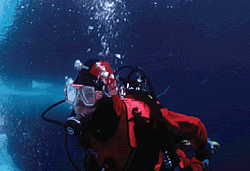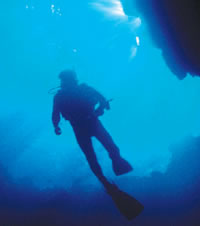
 Why Does a Diver Need a Heater?
Unless the water temperature is greater than 90º F, you will
lose heat. The human body must maintain a constant core
temperature for efficient metabolism. Even a minor drop of only
a degree or two can cause some adverse effects. Our body’s
response to decreased core temperature is a complex process. A
diver experiencing “mild” hypothermia will feel cold, most
noticeably in the extremities. Also common is an accelerated
heart rate and increased urge to urinate.
Vasoconstriction (narrowing of the blood vessels) will shift
the blood from the periphery into the core, which is interpreted
by the body as a state of over-hydration. The brain shuts off
production of antidiuretic hormones, causing the diver urinate
frequently. As the urine is at body temperature, significant
heat is lost along with the fluid output. Shivering usually
occurs as an early symptom only if the diver isn’t vigorously
swimming or is not engaged in other physical activity. That
means the diver can delay shivering or completely suppress it
depending on activity.
When we’re exposed to cold on land, an effective way to warm
up is by exercising. As you know, even on the coldest days, you
can exercise to a point where you perspire. Some assume that
these techniques can work well underwater. Unfortunately, that’s
not the case. While increased exercise may make you feel warmer,
it masks what’s actually happening to your body. Increased
exercise does increase heat production, but the water drains the
heat away faster than you can produce it. So the net effect of
trying to warm up by vigorous swimming is merely to increase the
amount of heat lost. The inevitable outcome of this practice is
a cold and tired diver with shorter than otherwise bottom time.
Scientists have demonstrated that nitrogen narcosis can
inhibit the shivering response, eliminating an important warning
sign of hypothermia.
Most divers assume that only “northern divers” need to worry
about heat loss; tropical divers have nothing to worry about. In
reality, understanding heat loss is critical to all divers,
because of a phenomenon known as warm-water or undetected
hypothermia. Unlike in cold water, heat loss in warm water is
slow and gradual. This long, slow cooling of the body can
significantly lower core temperature. The phenomenon has been
documented in divers engaging in diving for several days in
temperatures as high as 81º F without long periods of rest
between dives ---a typical scenario for a diving vacation. Under
these circumstances, the skin temperature remains within comfort
range, while the core temperature slowly and insidiously drops
over time. The most common symptoms of undetected hypothermia
are fatigue, loss of motivation and impaired mental ability. The
research has indicated that this form of cooling may not
stimulate shivering until the diver is significantly
hypothermic.
Upon immersion, a diver begins loosing heat by conduction.
Even in the full 7mm wet suit, heat loss can be accelerated by
water flushing trough the suit due to vigorous swimming or
improper fit. On descend, the wet suit compresses and loses its
effectiveness. On a deep dive, the 7mm wet suit might only
provide the protection of a 3mm suit. A dry suit offers better
protection; however, it also has its limitations. It uses air as
an insulator, which is trapped in the undergarment. The
otherwise fluffy undergarment will be also compressed by the
water pressure, thus losing its full effectiveness. Adding more
air into the suit to increase the airspace between the suit and
the skin will only create a bubble at the highest point of the
suit. If the diver could wear a more rigid undergarment, which
would not compress as easily, he would then be excessively
buoyant, requiring enormous weight to descend. The wet suit
diver could increase the suit thickness, but besides losing his
mobility he would face the same dilemma trying to descent.
The diving suit manufacturers have reached a dead end in the
development of PASSIVE THERMAL PROTECTION SYSTEMS.
Regardless of the effectiveness of any exposure suit, no suit
used by sport divers can stop heat loss. At best, even the most
expensive suit can only slow the process. With the introduction
of rebreathers, mixed gases, underwater propulsion vehicles etc.
our bottom times have increased. However, the bottom time, until
now, has always been limited by the EXPOSURE TIME. Not anymore!
A big breakthrough in diving:
ACTIVE THERMAL PROTECTION SYSTEM
PATCO Inc. is the leader and
innovator in wet and dry suit heaters. As you now know, the only
way to keep warm while diving is with supplemental heat. The
diver simply takes the heat with him on the dive. All he will do
is basically remove a portion of the lead weight from his weight
belt (which only provides gravity) and substitute it with an
energy source. The lead weight is in the form of a battery pack.
The only difference is that instead putting it back on the
weight belt, it is attached to a scuba tank. It provides an
energy, which keeps the diver warm in all diving conditions.
Supplemental heat is the future of diving.
AQUA HEAT was
designed not only for diving, but other sport activities as
well, such as hunting, motorcycle riding, snowmobiling, camping
and even skiing. You can take it to the ball game or use it
while working on your car. Its use is limited only by your
imagination.
The future is even more exciting. As the battery packs
decrease in size and increase in capacity with newly emerging
technology, diving will be changed forever. Can you imagine a
3mm fully heated suit, powered by an energy pack that fits
inside the BCD pocket, with a dial to select a comfort level for
the entire dive trip? You won’t have to worry about cold water,
wind or thermo clines. We are not there yet but such wonders may
be available in the near future.
The conclusion from this discussion is clear. Unless the
water temperature is above 90ºF, the question isn’t whether or
not you are losing heat; it’s how much you are losing. We rate
the core temperature on a scale from zero to ten. At ten you are
fully regenerated. One more point and you will start sweating.
If you reach zero, you have lost so much heat that you will
start shivering. As you learned previously, the shivering point
will be delayed unless the diver is motionless. If the diver’s
core temperature is anywhere between one and ten, he will not
have any symptoms of being cold.
If you are ten before jumping into water, you will have a
great advantage over divers who are, let’s say, five or even
three. Your core temperature will drop, but hopefully, you will
finish your dive before it drops to zero. So the next time
someone tells you they dive in cold water but don’t get cold,
you’ll know better. Just because they don’t feel it, doesn’t
mean their body isn’t cold. They are either delaying the
shivering point or they just don’t have enough bottom time.
Scuba diving is a beautiful and exciting sport. We need to be
warm to maximize our enjoyment. There are sometimes rough seas,
cold water, strong currents, bad visibility, gloomy weather and
sometimes you get cold. There is not much we can do about the
diving conditions, but you can always dive warm.
The new technology is here and it is for everyone.
More info
|
Copyright© 2003 Patco, Inc.
Web Design by Ambitious Web
PATCO is a manufacturer of AQUA HEAT, AQUA
LITE(also know as Aqua Light) and AQUA GUNS. In simple terms, we make wetsuit
and drysuit heaters, underwater lights, 10 watt hid light heads, spearguns and
spearfishing accessories. Patco’s scuba diving equipment is high quality,
technologically advanced, state of the art, fully guaranteed, and are geared to
safety, enjoyment, comfort, and maximum value.
|
|